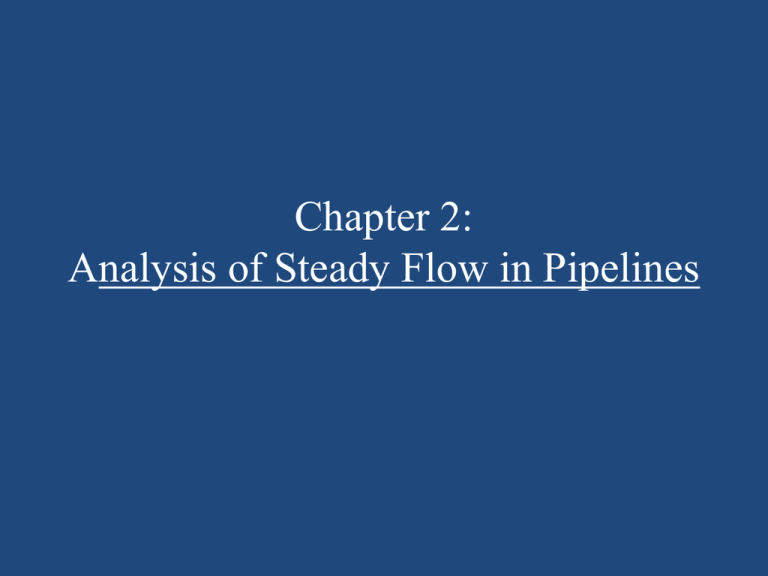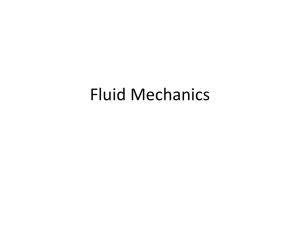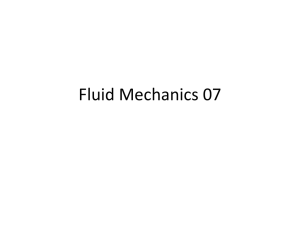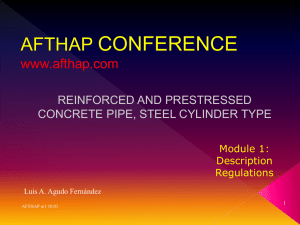Chapter 2: Analysis of Steady Flow in Pipelines
advertisement

Chapter 2: Analysis of Steady Flow in Pipelines Learning outcomes • To apply energy equation in pipes • To analyze of flow and piping systems including pipe in series and pipes in parallel by applying energy equations • To analyze pipe systems consist numerous pipes connected in a complex manner with general entry and withdrawal points by using Quantity Balance Method UiTMKS/ FCE/ BCBidaun/ ECW301 2 Content • • • • • • • Introduction Incompressible flow through pipes Flow through pipes in series Flow through pipes in parallel Flow through branching pipes Pipe networks Quantity Balance Method UiTMKS/ FCE/ BCBidaun/ ECW301 3 Introduction • This chapter concerned with the analysis of flow in pipes and piping systems including pipe in series and pipes in parallel. • Dealing with flow in circular pipes flowing full under steady conditions and flowing under gravity. • Analyses problems involving pipelines, e.g. flow between reservoirs, water flow from a reservoir discharging to atmosphere, from higher to lower elevation reservoir or vice versa. UiTMKS/ FCE/ BCBidaun/ ECW301 4 Introduction • Normally uses energy and continuity equation to solve problems. • Method of solving: – Number of equations needed is the same as the number of unknowns to be solved – Successive corrections until the continuity equation is satisfied (trial & error) UiTMKS/ FCE/ BCBidaun/ ECW301 5 Incompressible flow through pipes • Incompressible : density is constant throughout • For a circular cross-section conduit flowing full: – Head loss due to friction by Darcy Weisbach (2.1) 4 fLv 2 hf 2 gd – Pressure loss by Darcy Weisbach 4 fLv 2 p 2d (2.2) UiTMKS/ FCE/ BCBidaun/ ECW301 6 Incompressible flow through pipes • But v Q d 2 4 • Therefore (2.1) & (2.2), 2 flQ hf 3.03d 5 3.24 flQ p 5 d (2.3) 2 (2.4) UiTMKS/ FCE/ BCBidaun/ ECW301 7 Example 2.1(Douglas, 2006) • Water discharges from reservoir A through a 100 mm diameter pipe, 15 m long, which rises to the highest point at B, 1.5 m above the free surface of the reservoir and discharges direct to the atmosphere at C, 4 m below the free surface at A. The length of pipe L1 from A to B is 5 m and the length of pipe L2 from B to C is 10 m. Both the entrance and exit of the pipe are sharp and the value of f is 0.08. Calculate, – The mean velocity of the water leaving the pipe at point C – The pressure at point B UiTMKS/ FCE/ BCBidaun/ ECW301 8 B 2m A L1 L2 4m C UiTMKS/ FCE/ BCBidaun/ ECW301 9 Flow through pipes in series • Pipes in series are pipes of different diameters are connected end-to-end to form pipeline to form a pipeline. • The total loss of energy, or pressure loss, over the whole pipeline will be the sum of the losses for each pipe together with any separation losses that might occur at the junctions. UiTMKS/ FCE/ BCBidaun/ ECW301 10 Example 2.2 (Douglas, 2006) • Two reservoirs A and B have a difference level of 9 m and are connected by a pipeline 200 mm in diameter over the first part AC, which is 15 m long, and then 250 mm diameter for CB, the remaining 45 m length. The entrance to and exit from the pipes are sharp and the change of section at C is sudden. The friction coefficient f is 0.01 for both pipes. List the losses of head that occur and calculate the system flow rate. UiTMKS/ FCE/ BCBidaun/ ECW301 11 UiTMKS/ FCE/ BCBidaun/ ECW301 12 Apr 2010 • Two pipes are connected in series and is used to connect two reservoirs as shown in Figure Q2(b). Both pipes are 500 m long and have diameters of 0.7 m and 0.5 m respectively. The discharge from reservoir A to reservoir B is 0.8 m3/s and the elevation of water surface in reservoir A is 85 m. Using the appropriate equations and assuming sharp exit and entry as well as existence of sudden contraction at the junction, determine : – velocity for each pipe – head losses due to friction, separation and fittings – elevation of water surface in reservoir B (Cc = 0.674, μ = 1.14 x 10-3 Pa.s and k = 0.15 mm) UiTMKS/ FCE/ BCBidaun/ ECW301 13 UiTMKS/ FCE/ BCBidaun/ ECW301 14 Incompressible flow through pipes in parallel • When two reservoirs are connected by two or more pipes in parallel, the fluid can flow from one to the other by a number of alternative routes. • Difference in head h available to produce flow will be the same for each pipe. • Thus pipe can be considered separately, independent of other parallel pipes. • Steady flow energy equation can be applied for flow by each route. • The total volume rate of flow will be the sum of volume rates of flow in each pipe. UiTMKS/ FCE/ BCBidaun/ ECW301 15 Example 2.3 (Douglas, 2006) • Two sharp-ended pipes of diameter d1 = 50 mm, and d2 = 100 mm, each of length L = 100 m, are connected in parallel between two reservoirs which have a difference of level h = 10 m, as in figure. If the Darcy coefficient f = 0.008 for each pipe, calculate, a. the rate of flow for each pipe, b. diameter D of a single pipe 100 m long that would give the same flow if it was substituted for the original two pipes. UiTMKS/ FCE/ BCBidaun/ ECW301 16 Incompressible flow through branching pipes • Branching pipes - consist of one or more pipes that separate into two or more pipes • The basic principles that must be satisfied are: • Continuity - at any junction the total mass flow rate towards the junction must be equal the total mass flow rate away from it • There can be only one head value at any point • The energy equation must be satisfied for each pipe UiTMKS/ FCE/ BCBidaun/ ECW301 17 • Figure 2.4 shows a simple branching pipe system where there are three tanks connected by three pipes that join at D • Actual direction of flow depends on – Tank pressures and elevation – Diameters, length and kinds of pipe • The system must satisfy two equation i.e. Darcy Weisbach and continuity equation UiTMKS/ FCE/ BCBidaun/ ECW301 18 UiTMKS/ FCE/ BCBidaun/ ECW301 19 • The inflow and outflow at the junction D must be equal (continuity equation) • The flow must be from the highest tank to the lowest tank. • Therefore, continuity equation can be Q1 Q2 Q3 or Q1 Q2 Q3 UiTMKS/ FCE/ BCBidaun/ ECW301 20 • If the HGL at junction D is above the elevation of the intermediate tank B – the water is flowing into tank B. • If the HGL at junction D is below tank B – the water is flowing out from tank B. • General problem: to find the flow rate in each pipe UiTMKS/ FCE/ BCBidaun/ ECW301 21 Example 2.4 (Douglas, 2006) • Water flows from reservoir A through a pipe of diameter d1 = 120 mm and length L1 = 120 m to junction D, from which a pipe of diameter d2 = 75 mm and length L2 = 60 m leads to reservoir B in which the water level is 16 m below that in reservoir A. A third pipe of diameter d3 = 60 mm and length L3 = 40 m, leads from D to reservoir C, in which the water level is 24 m below that in reservoir A. Taking f = 0.01 for all the pipes and neglecting all losses other than those due to friction, determine the discharge in each pipe. UiTMKS/ FCE/ BCBidaun/ ECW301 22 UiTMKS/ FCE/ BCBidaun/ ECW301 23 Pipe networks • A pipe network is a set of pipes which are interconnected so that the flow from a given input or to a given outlet may come through several different routes. UiTMKS/ FCE/ BCBidaun/ ECW301 24 • An alternative approach is used to analyse the systems by means of successive approximations, assuming values for the flow in each pipe, or the heads at each junction, and checking whether the values chosen satisfy the requirements: – The loss of head between any two junctions must be the same for all routes between these junctions Loss of head in pipe bc + Loss of = Loss of head in head in pipe de pipe bd + Loss of head in pipe ce – The inflow to each junction must equal the outflow from that junction UiTMKS/ FCE/ BCBidaun/ ECW301 25 Quantity balance method • Can be used when the heads at various points in a pipe network are known. • Estimate the head at each junction and Q is calculated for each pipe from the difference of head h between the junctions at each end of pipe and its resistance coefficient K by, 2 h KQ • If the inflow does not equal to outflow for each junction, the original estimated head must be corrected. UiTMKS/ FCE/ BCBidaun/ ECW301 26 • If the head at b has been overestimated by δh relative to the head at a, c, and d, the values of Qab and Qcb will be too small and the value of Qbd will be too great. • Differentiating h KQ 2 Q Q nh h UiTMKS/ FCE/ BCBidaun/ ECW301 27 • Therefore, the estimated head at b is reduced by δh, the flows in ab and cb will be increased to Qab + δQab and Qcb + δQcb. • If the flows are correct, inflow and outflow at b will be balanced: Flow in ab Flow in cb Flow in bd Qab Qab Qcb Qcb Qbd Qbd UiTMKS/ FCE/ BCBidaun/ ECW301 28 • If hAD, hBD and hDC , are the assumed losses in pipe ab, cb and bd, used to calculate Qab, Qcb and Qbd, Qab Qab h nhab Qcb Qcb h nhcb Qbd Qbd h nhbd UiTMKS/ FCE/ BCBidaun/ ECW301 29 • Substituting, Flow in ab Flow in cb Flow in bd Q Q Q Qab ab h Qcb cb h Qbd bd h nhab nhcb nhbd Q Qcd Qbd h ab Qab Qcb Qbd nhab nhcb nhbd Q h Q nh • Sign convention: flow towards junction b both Q and h are posititve UiTMKS/ FCE/ BCBidaun/ ECW301 30 Q Q AD QBD QDC Algebraicsum of theflows towardsthe junction • The process is repeated until ΣQ has been reduced to negligible quantity (approaching zero) UiTMKS/ FCE/ BCBidaun/ ECW301 31 Example 2.5 (Douglas, 2006) • A reservoir A with its surface 60 m above the datum supplies water to a junction D through a 300 mm diameter pipe, 1500 m long. From the junction, a 250 mm diameter pipe, 800 m long, feeds reservoir B, in which the surface level is 30 m above datum, while a 200 mm diameter pipe, 400 m long, feeds reservoir C, in which UiTMKS/ FCE/ BCBidaun/ ECW301 32 UiTMKS/ FCE/ BCBidaun/ ECW301 33 Example 2.6 (Douglas, 2006) • Water flows in the parallel pipe system as shown in figure for which the following data are available: Pipe Diameter (m) Length (m) f AaB 0.10 300 0.0060 AbB 0.15 250 0.0050 AcB 0.20 500 0.0050 UiTMKS/ FCE/ BCBidaun/ ECW301 34 • The supply pipe to point A is of 0.30 m diameter and the mean velocity of water in it is 3 m/s. If the elevation of point A is 100 m and the elevation of point B is 30 m above datum, calculate the pressure at point B if that at A is 200 kPa. What is the discharge in each pipe? Neglect all minor losses. UiTMKS/ FCE/ BCBidaun/ ECW301 35 Review of past semesters’ questions UiTMKS/ FCE/ BCBidaun/ ECW301 36 Oct 2010 • Water flows from reservoir A through pipe 1 to junction J which in turn flows to reservoir B through pipe 2 and reservoir C through pipe 3 as shown in figure. Using analytical method and neglecting all losses other than those due to friction, determine the flow rate and velocity for each pipe. Assume that the friction factor, f is 0.01 for all pipes. UiTMKS/ FCE/ BCBidaun/ ECW301 37 UiTMKS/ FCE/ BCBidaun/ ECW301 38






